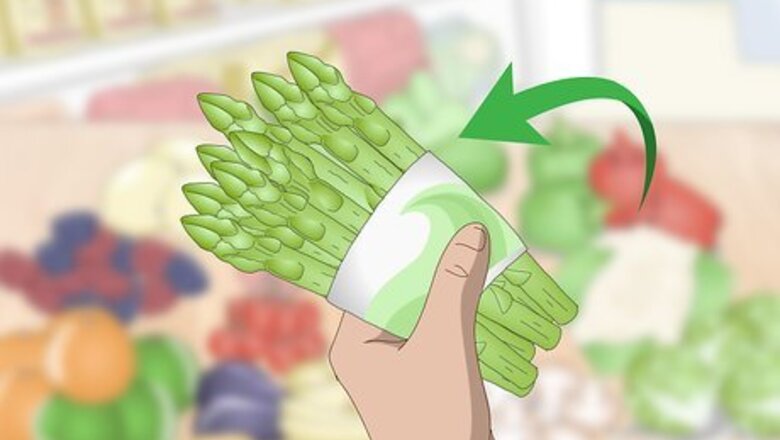
views
X
Research source
Buying Fresh Asparagus
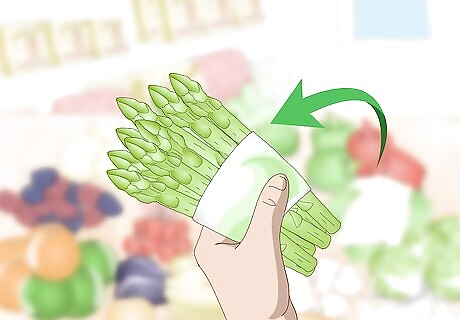
Choose asparagus in the spring from a local source. Seek out asparagus at a local farmer's market to find the freshest local produce. This asparagus will be the ripest. Asparagus from Latin America is available internationally year-round if your local asparagus is not in season. If you live in the U.S., asparagus is ripest from February to May on the West Coast and from May to June on the East Coast.
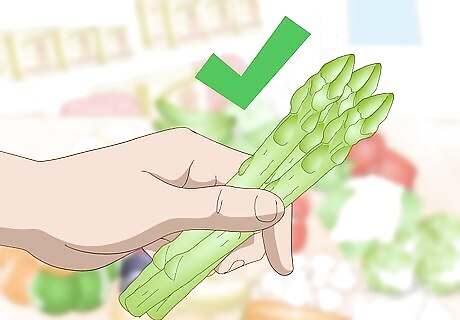
Look for spears that are brightly colored. Seek out asparagus in your preferred variety that is vividly colored. Asparagus comes in 3 varieties: white, green, and purple. White asparagus should be bright white to slightly yellow. Green asparagus should be Kelly green with darker tips and ends, and purple asparagus should be a brilliant, dark violet. Brightly-colored asparagus is fresh and in good condition. There is little nutritional difference between the different colors of asparagus. Compared to green and purple asparagus, white asparagus may be more mild and turnip-like in flavor.
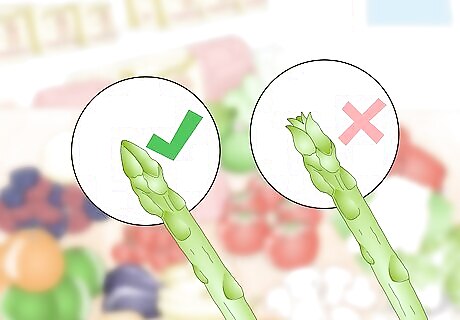
Look for compact, tightly-closed tips. Inspect the tips of the asparagus bunches for dense, closed tips. Asparagus that have begun to blossom or are falling apart are not at the peak of freshness for eating.
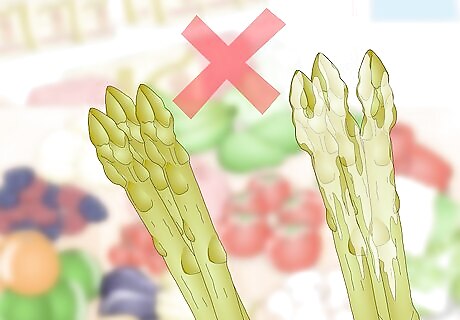
Pass over any asparagus that looks dried out or slimy. Look for asparagus that is unblemished and healthy. Avoid asparagus bunches with dried out stalks or tips that have begun to brown. The same goes for asparagus that is sticky, which may be a sign of rot or damage. If you don't feel confident about selecting asparagus, ask a grocery store associate or farm stand owner to help you select a nice bunch. Some asparagus may be stored upright in water at the grocery store. Assuming the water looks clear, this will keep the produce fresh longer. Avoid any slimy-looking asparagus stored in cloudy water.
Storing Your Asparagus
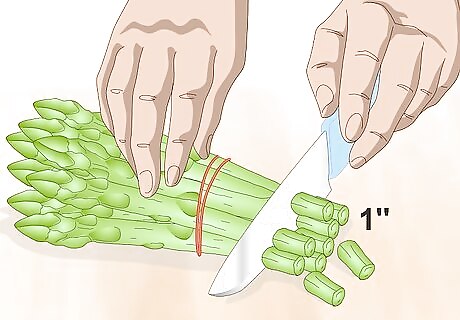
Trim 1 inch (2.5 cm) off the ends of the asparagus at home. Keep your asparagus in its rubber band, and cut about an inch off the bottom using a sharp knife. If your asparagus bunch is too thick to cut through, remove the rubber band and separate the bunch into 2 smaller bunches to trim. Trimming the asparagus at this stage removes the dead ends, allowing them to draw up water while being stored.
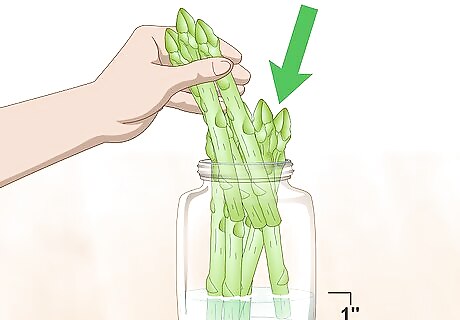
Stand your trimmed asparagus up in a glass container. Fill the container with about 1 inch (2.5 cm) of fresh water. Choose a glass container with tall sides, so your container won't tip over. Place the asparagus in the fridge. A mason jar or other narrow container works well to hold your asparagus vertically.
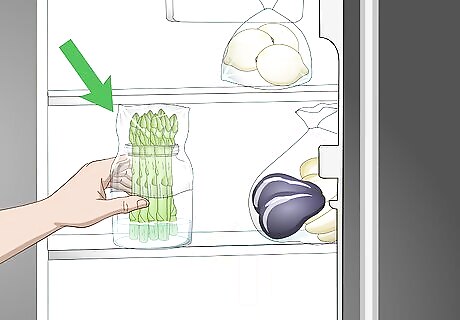
Store your asparagus in the refrigerator for up to 1 week. Cover your trimmed asparagus loosely with a plastic bag. Change the water if it begins to look cloudy. For the best results in your recipe, cook your asparagus within a week. If your asparagus browns or turns slimy, it is past its prime. Throw it out.
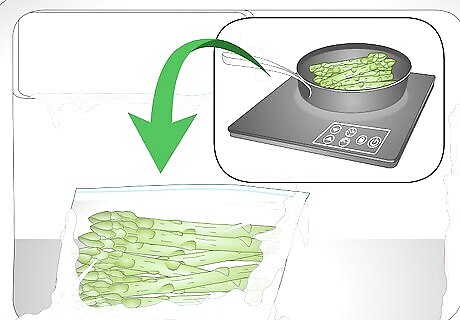
Freeze only cooked asparagus. Avoid freezing raw asparagus, as it doesn't keep well. To store your asparagus, cook it as desired and freeze it in a covered, airtight container within 2 hours of cooking. Cooked asparagus will keep for up to 10 months in the freezer. Thaw frozen asparagus in the refrigerator overnight. Eat thawed, frozen asparagus within 3-4 days.
Washing and Trimming Your Asparagus
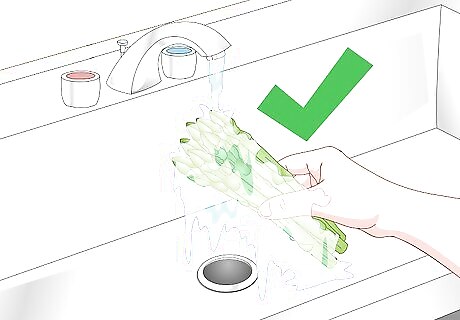
Wash the asparagus spears. Rinse your asparagus under cool tap water to wash off any sand or dirt. Dry the asparagus by rolling each spear gently between 2 kitchen towels, taking care not to damage the tips. Set your cleaned asparagus aside.
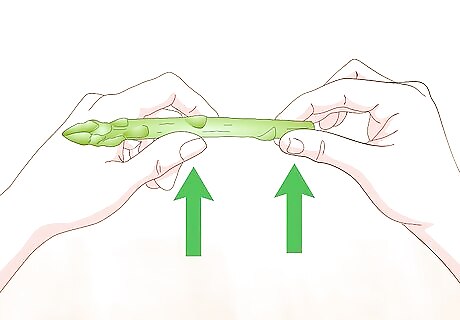
Pinch each asparagus between your fingers using both hands. Pinch your fingers around the asparagus, putting 1 pinch in the middle of the asparagus using 1 hand and the other pinch at the thick end with your other hand.
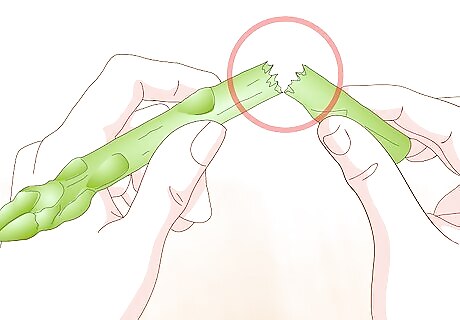
Bend each asparagus until it snaps at its natural breaking point. Gently bend the asparagus until it snaps in 2 pieces on its own. If your asparagus is at the end of its week in the fridge, you may need to apply a little force to get it to snap. This natural break will occur at the place where the asparagus has started to lose its moisture. You'll likely end up with spears of different lengths; that's okay! Discard the thick, woody ends of the asparagus, reserving the tender upper halves.
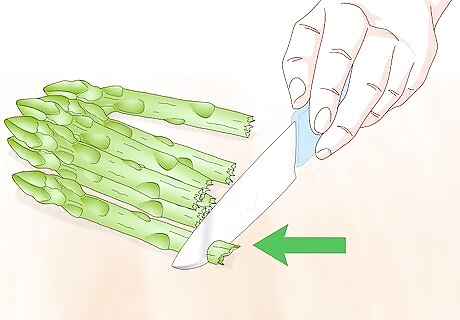
Trim off the uneven ends with a sharp knife. Use a sharp knife to create an even cut at the new, broken end of the tender spears. Trim off as little as possible, to preserve your delicious, moist asparagus.
Cooking Your Asparagus
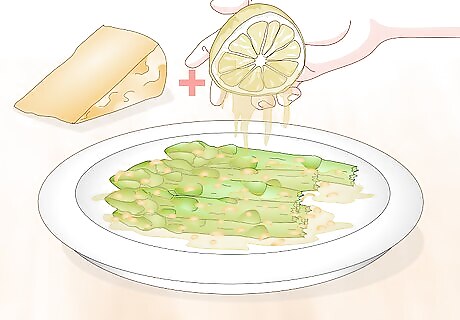
Create a simple preparation of asparagus with Parmesan and lemon. Blanch 1 pound (0.45 kg) of asparagus for 2 minutes and drain the hot water. While the asparagus are still warm, toss them with 2 tablespoons (10 g) of Parmesan cheese, a teaspoon of lemon zest, and 2 tablespoons (30 mL) of olive oil. Season the asparagus with salt and pepper to your taste.
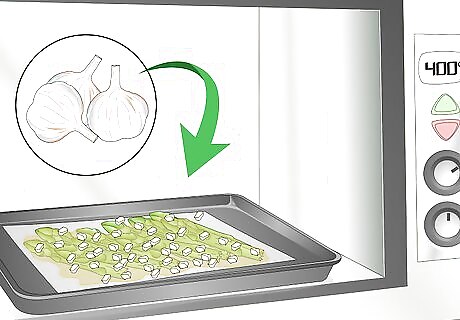
Roast your asparagus with garlic for a tasty side dish. Heat your oven to 400 °F (204 °C). Over medium heat on the stovetop, cook ⁄2 cup (120 ml) of olive oil, 8 cloves of minced garlic, 1 teaspoon (5 g) of onion powder, and 2 tablespoons (10 g) of chopped parsley until your garlic is fragrant but not brown. Drizzle the oil mixture over 2 pounds (0.91 kg) of thin asparagus, and season with salt and pepper. Roast your asparagus on a sheet pan for 8-10 minutes. When done, the asparagus should be bright green, deep purple, or slightly yellowed white, depending upon what type of asparagus you're using.
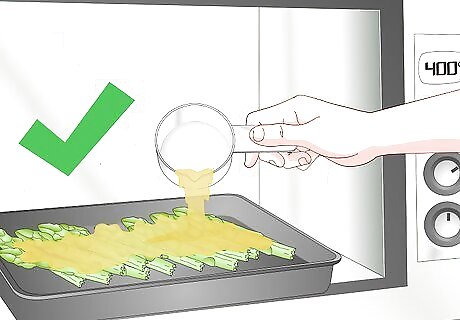
Create a cheesy roasted asparagus casserole. Place 2 pounds (0.91 kg) of prepared asparagus in a shallow baking dish, and heat your oven to 400 °F (204 °C). Pour ⁄4 cup (180 ml) of heavy cream over the asparagus and sprinkle the cream with 3 minced cloves of garlic. Scatter the top with 2 cups (250 g) of your favorite shredded cheese, such as provolone or mozzarella. Bake the dish until the cheese is bubbly and golden, about 25-30 minutes.




















Comments
0 comment